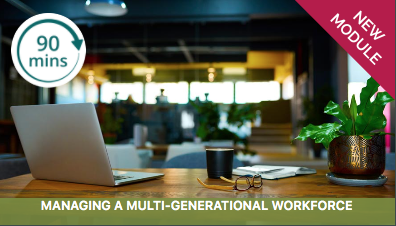"For the first time in history, the composition of our workforces is truly multi-generational and there are now five generations represented, each with its own talents and skillsets," according to our Professional Refresher module on multi-generational workforces. The module covers the associated management challenges, breaking the topic into four chapters:
- Introduction and background
- Talent, technology and training
- Flexibility, engagement and communication
- An effective multi-generational team.

1. Introduction and background
People are working later in life, with an increasing percentage of people in their 60s, 70s and sometimes 80s still working, whether that be on a full-time or part-time basis.
For the purpose of the module, the generations are split into five categories:
- traditionalists – born 1925–1945
- baby boomers – born 1946–1963
- generation X – born 1964–1980
- millennials – born 1981–1994
- generation Z – born 1995 onwards.
According to the module, "With five generations now in the workforce, there is a heightened potential for age discrimination, especially with unconscious bias and negative assumptions and preconceptions about generations."
Understanding the differences
A multi-generational workforce will have benefits, such as a diverse set of talents and skills. Different generations will have different preferred communication styles, work styles and general behaviour. For example, generation Xers and millennials may prefer to learn independently, using online tools, as they are digital natives who are likely to be tech-savvy, while baby boomers and traditionalists may prefer paper-based training methods.
2. Talent, technology and training
"Traditionally, a professional skill, when acquired and mastered, had a shelf life of around 20 years before the skill would be replaced with ‘a new way to do things’ coupled with new technology," says the module. However, in the modern workplace, the shelf life can be as low as five years. This means there's an increasing need, and opportunity, to learn and relearn skills.
Providing staff with opportunities to reskill is a way to engage workers across generations, reduce staff recruitment costs and improve staff retention. While technology does of course provide positive opportunities for training, “it can also present a challenge for some generations”, but pairing older and younger generations in a mentoring style of training enables those less familiar with technology to be brought up to speed.
3. Flexibility, engagement and communication
Across a multi-generational workforce, preferences for communication will differ, and this can be a challenge. According to research by Robert Half Management Resources published in 2017, 30% of surveyed business executives find that communication skills represent the greatest difference among employees from different generations.
Email communication is often used as a fast and informal way to correspond, as "formality in every communication in the workplace is not always needed". A face-to-face chat or phone/video call can be a more detailed communication method.
While preferences for communication may differ and there are specific traits among each generation, it is important to establish what workers prefer on an individual level rather than assuming based on stereotypes. For example, millennials may be happy to have a face-to-face chat rather than communicating via text.
4. An effective multi-generational team
Set clear objectives and expectations. By doing so, all team members are clear on what is expected of them, regardless of age or generation.
A flexible approach, taking into account the different needs of each generation, will result in high performing employees. "It is, of course, important to be equitable to the best extent possible so there can be no accusations of favouritism towards certain groups."
Different generations may expect different leadership styles. "Millennials are more likely to treat management as equals and look to collaborate with them, while baby boomers may expect a more authoritative approach with instructional style management and generation X employees may require a more hands-off approach."
Keeping an open dialogue between teams and management can help "break down generational differences and styles". Identifying the different skills and strengths present in the team is key to a successful workforce. An older employee may have years of experience in giving presentations, for example.
A multi-generational workforce is full of opportunities, and with strong communication, clear objectives and an open dialogue, the team can work to its full potential.